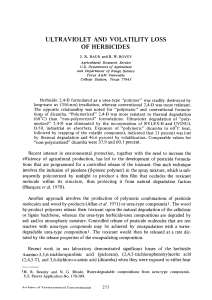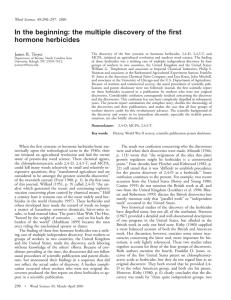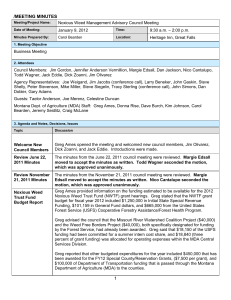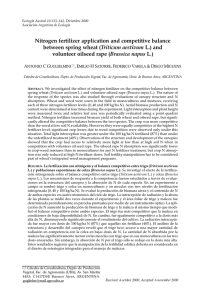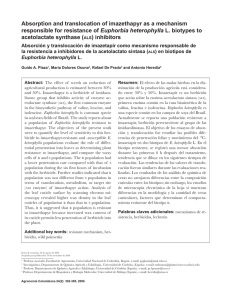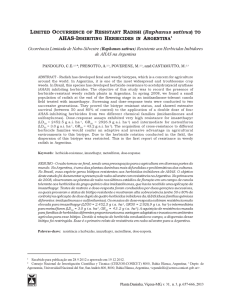Efficacy of herbicide dose and plant growth stage on weeds present
Anuncio
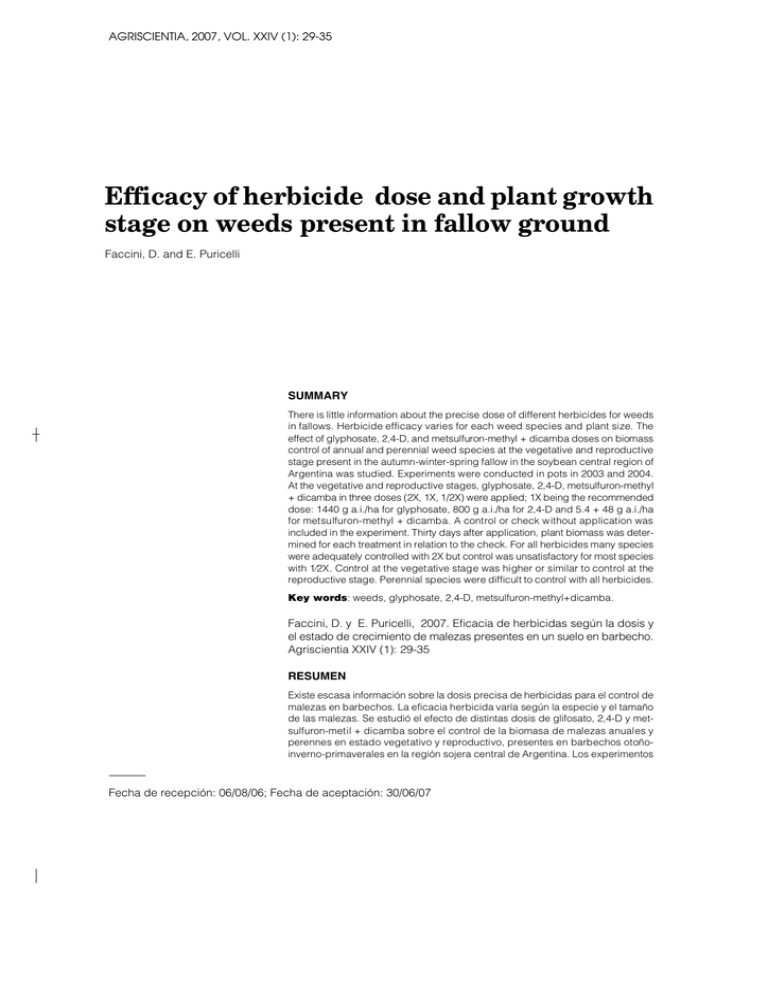
AGRISCIENTIA, 2007, VOL. XXIV (1): 29-35 Efficacy of herbicide dose and plant growth stage on weeds present in fallow ground Faccini, D. and E. Puricelli SUMMARY There is little information about the precise dose of different herbicides for weeds in fallows. Herbicide efficacy varies for each weed species and plant size. The effect of glyphosate, 2,4-D, and metsulfuron-methyl + dicamba doses on biomass control of annual and perennial weed species at the vegetative and reproductive stage present in the autumn-winter-spring fallow in the soybean central region of Argentina was studied. Experiments were conducted in pots in 2003 and 2004. At the vegetative and reproductive stages, glyphosate, 2,4-D, metsulfuron-methyl + dicamba in three doses (2X, 1X, 1/2X) were applied; 1X being the recommended dose: 1440 g a.i./ha for glyphosate, 800 g a.i./ha for 2,4-D and 5.4 + 48 g a.i./ha for metsulfuron-methyl + dicamba. A control or check without application was included in the experiment. Thirty days after application, plant biomass was determined for each treatment in relation to the check. For all herbicides many species were adequately controlled with 2X but control was unsatisfactory for most species with 1⁄2X. Control at the vegetative stage was higher or similar to control at the reproductive stage. Perennial species were difficult to control with all herbicides. Key words: weeds, glyphosate, 2,4-D, metsulfuron-methyl+dicamba. Faccini, D. y E. Puricelli, 2007. Eficacia de herbicidas según la dosis y el estado de crecimiento de malezas presentes en un suelo en barbecho. Agriscientia XXIV (1): 29-35 RESUMEN Existe escasa información sobre la dosis precisa de herbicidas para el control de malezas en barbechos. La eficacia herbicida varía según la especie y el tamaño de las malezas. Se estudió el efecto de distintas dosis de glifosato, 2,4-D y metsulfuron-metil + dicamba sobre el control de la biomasa de malezas anuales y perennes en estado vegetativo y reproductivo, presentes en barbechos otoñoinverno-primaverales en la región sojera central de Argentina. Los experimentos Fecha de recepción: 06/08/06; Fecha de aceptación: 30/06/07 30 AGRISCIENTIA se realizaron en macetas, con las plantas en estado vegetativo y reproductivo, durante los años 2003 y 2004. Se utilizaron los herbicidas glifosato, 2,4-D y metsulfuron-metil + dicamba en tres dosis (2X, 1X, ?X); 1X es la dosis recomendada (1440 g i.a./ha para glifosato, 800 g i.a./ha para 2,4-D y 5,4 + 48 g i.a./ha para metsulfuron-metil + dicamba). Se incluyó un testigo sin aplicación de herbicidas. Treinta días luego de la aplicación, la biomasa de las plantas se determinó en cada tratamiento en relación con el testigo sin control. Para todos los herbicidas numerosas especies fueron adecuadamente controladas con 2X, pero el control no fue satisfactorio para la mayoría de las especies con 1⁄2X. El control al estado vegetativo fue mayor o igual en relación al reproductivo. Las especies perennes fueron difíciles de controlar. Palabras clave: malezas, glifosato, 2,4-D, metsulfuron-metil + dicamba. D. Faccini. Cátedra de Malezas. Facultad de Ciencias Agrarias. Univer sidad Nacional de Rosario. Consejo de Investigaciones de la Univer sidad Nacional de Rosario. E. Puricelli. Cátedra de Terapéutica Vegetal. Facultad de Ciencias Agrarias. Universidad Nacional de Rosario. Con sejo de Investigaciones de la Universidad Nacional de Rosario. Correspondence to: [email protected] INTRODUCTION Fallow is a common practice in many regions and herbicides may be necessary to control weeds in these systems (Derksen et al., 1995). In the soybean central region in Argentina, fallow between soybean monocultures or summer crop rotations including soybean and maize is a usual practice. There is little information about the dose necessary to control weeds in fallows. The efficiency of herbicides on weeds is influenced by dose (Steckel et al., 1997). Generally, high herbicide doses are recommended but these doses may be an overestimation of the amount required to obtain adequate control. Promising ways to minimise herbicide consumption include the use of low doses (Zoschke, 1994). However, as the surviving weeds will be able to set seed and, when incorporated to the seed bank, weed populations may increase in the following years, the effective herbicide dose must be precisely known. Weed species vary in their susceptibility to herbicides and there is growing concern due to the increase of species difficult to control with herbicides. Perennial weeds are difficult to control because there are few selective herbicides and the non-selective ones require high doses or multiple applications and usually require a combination of herbicides and cultural practices. Furthermore, as weeds increase in size, they become less susceptible to herbicides (Devlin et al., 1991, Klingaman et al., 1991, Blackshaw & Harker, 1997). Weed size may influence the performance of reduced glyphosate rates (Vanlieshout & Loux, 2000). Although the effect of weed species type and plant growth stage on herbicide efficacy is widely known, the minimum reduced dose that controls weeds effectively has seldom been determined. The composition, abundance and diversity of weed species in the weed community present in fallow at Zavalla (Argentina) have been assessed for several years (Puricelli & Tuesca, 2006). However, as the results of control may vary greatly, it is important to study the effect of herbicides on most of the species present in that community at different growth stages to establish and compare the adequate doses which may lead to more efficient weed control. The objective of this experiment was to study the efficacy of glyphosate, 2,4-D, and metsulfuronmethyl + dicamba doses on biomass control of weed species at the vegetative and reproductive stages, present in the autumn-winter-spring fallow between summer crops in the soybean central region of Argentina. MATERIALS AND METHODS Experimental procedures Experiments were conducted at the University of Efficacy of herbicide dose and plant growth stage on weeds present in fallow ground Rosario Experimental Farm at Zavalla (Lat. 33° 01’ S Long. 60º 53’W). Soil obtained from the site was sieved through a 5-mm screen and pasteurised for 24 h at 80º C. Plastic pots with drainage holes (18 cm in diameter for species of smaller size and 28 cm for species of larger size containing 8 kg of sieved soil (for species of smaller size) and 15 kg for species of larger size. The experiment was replicated twice, in 2003 and 2004. Seeds collected in 2002 were sown in the pots in May (first seeding) and July (second seeding) each year of the experiment. Pots were kept in the open air to represent natural light and temperature conditions during fallow, and watered when necessary. At approximately 2-3 leaf stage, plants were thinned to 1 per pot. The experiment design for each year was a split-split-split plot considering species —Ammi majus L., Anagallis arvensis L., Artemisia annua L., Bowlesia incana Ruiz & Pav., Capsella bursa-pastoris (L.) Medik., Carduus acanthoides L., Centaurium pulchellum (Sw.) Druce, Cirsium vulgare (Savi) Ten, Convolvulus arvensis L. , Conyza bonariensis (L.) Cronquist, Coronopus 31 didymus (L.) Sm., Cotula australis (Sieber) Hook. f., Descurainia argentina O. E. Schulz., Gamochaeta spicata (Lam.) Cabrera, Hypochoeris brasiliensis (Less.) Benth. & Hook., Iresine diffusa Humb & Bonpl., Lamium amplexicaule L., Oenothera indecora Cambess., Parietaria debilis G. Forst., Plan tago tomentosa L a m ., Rapistrum rugosum (L.) All., Rumex paraguayensis D. Parodi, Sonchus oleraceus L., Stellaria media (L.) Cirillo, Taraxacum officinale G. Weber, Trifolium repens L., Urtica urens L., V e r bena litoralis Kunth, Veronica persica Poir., Senecio grisebachii Baker, Veronica peregrina L. vegetative and reproductive growth stages and 3 herbicides (glyphosate, 2,4-D and metsulfuron-methyl + dicamba) with 3 herbicide doses (2X, 1X, 1⁄2X) being X the recommended labeled dose, and a check without application. Recommended labeled doses used in this experiment were 1440 g a.i./ha for glyphosate triazolamine salt, soluble liquid 48%, 800 g a.i./ha for 2,4-D isobutyl ester, emulsifiable concentrate 100% , and 5.4 + 48 g a.i./ha for metsulfuron-methyl, dry flowable 60%+ dicamba dimethy- Table 1: Control (%) of the different weed species at the vegetative and reproductive stages using different glyphosate doses (Average of 2003 and 2004 data). Life Cycle Artemisia annua Capsella bursa-pastoris Carduus acanthoides Cirsium vulgare Convolvulus arvensis Conyza bonariensis Coronopus didymus Iresine diffusa Lamium amplexicaule Oenothera indecora Parietaria debilis Plantago tomentosa Rapistrum rugosum Rumex paraguayensis Sonchus oleraceus Stellaria media Taraxacum officinale Trifolium repens Urtica urens Verbena litoralis Veronica persica A A A A P A A A A A A P A P A A A P A A A Vegetative Stage 2X 100 100 100 100 100 100 100 100 100 100 100 100 100 100 100 100 100 82 100 100 100 1X a* a a* a a a a a* a a a a a a a a a b* a a a 100 100 100 100 55 100 100 65 100 90 100 98 98 87 100 100 100 40 100 100 98 Reproductive Stage 1⁄2X a* a* a* a* d* a a* d* a bc * a* a* a* c a a* a e a a* a 83 83 93 100 33 97 100 59 100 83 63 43 40 80 100 100 100 30 100 97 72 b* b* a* a* gh a* a* e* a* b* de f fg bc * a* a* a* h a* a* cd 2X 72 96 90 96 100 97 100 50 100 99 98 97 100 98 100 100 100 50 100 100 100 1X c a b a a a a d a a a a a a a a a d a a a 57 87 77 67 65 99 82 17 76 77 72 58 85 72 99 79 100 40 100 73 97 1⁄2X j bcd efg hi hij a def l efg efg gh ij cde gh a efg a k a fgh a 33 47 60 28 43 58 42 0 17 47 43 27 30 43 73 38 68 23 57 23 57 f d bc fg de c de i h d de f f de a e b g c g c Species with 100% control in all treatments (not included in the table) are: Ammi majus (A), Anagallis arvensis (A), Bowlesia incana ( A ) , Centaurium pulchellum (A), Cotula australis (A), Gamochaeta spicata (A), Hypochoeris brasiliensis (P), Senecio grisebachii (A), Veronica peregrina (A), Descurainia argentina (A). Averages followed by same letters are not different at (P = 0.05) as determined by LSD test. For the same species at the same dose * indicate significant differences between weed stages. A = Annual, P = Perennial. 32 AGRISCIENTIA lamine salt, soluble liquid 48%. For each weed stage, four pots were randomly assigned to each treatment and pots were equally spaced on the soil surface. Herbicide applications were made at the end of September. The applications were made with a CO2 backpack sprayer and delivered throughout 8003 flat-fan nozzles at 120 L ha.-1.and a pressure of 270 kPa. Thirty days after application, surviving plants were collected and oven dried at 80 ºC. For each treatment, weed control was evaluated determining plant biomass for each species without herbicide application in relation to biomass with herbicide application, as follows: Control (%) = (Biomass of check /Biomass of treatment with herbicide application) 100 Statistical analysis For each year biomass in percentage was analyzed after angular transformation (arc sin√(%/100) + 0.5) using a factorial design, with the effect of year assessed at one level (against the year x replicate residual term) and the remaining main effects and interactions compared at the lower level using the residual mean square to produce an analysis of the effects of year, species, growth stage, herbicide type, herbicide dose simultaneously. The analysis allows for a main effect of year and of replicates within year, and then for main effects of species, growth stage, herbicide type, herbicide dode together with interactions between pairs of treatments and the five factor interaction. Differences between control at vegetative relative to reproductive stage were determined using a t-test (P= 0.05). Table 2: Control (%) of the different weed species at the vegetative and reproductive stages with different 2,4-D doses (Average control for 2003 and 2004). Vegetative Stage 2X Ammi majus Artemisia annua Bowlesia incana Capsella bursa-pastoris Carduus acanthoides Centaurium pulchellum Cirsium vulgare Convolvulus arvensis Conyza bonariensis Coronopus didymus Cotula australis Gamochaeta spicata Hypochoeris brasiliensis Iresine diffusa Lamium amplexicaule Oenothera indecora Parietaria debilis Plantago tomentosa Rumex paraguayensis Senecio grisebachii Sonchus oleraceus Stellaria media Taraxacum officinale Trifolium repens Verbena litorales Veronica peregrina Veronica persica Rapistrum rugosum 100 100 100 82.6 98.6 86.7 96.0 100 98.3 100 98.3 100 100 100 100 100 10 100 88.3 56.7 92.3 88.3 100 81.7 100 100 85.0 100 1X a* a* a* c a* bc a a a* a* a* a a* a* a* a e a bc * d* ab bc a c a a c* a 100 100 80.0 83.3 98.3 40.0 63.3 100 93.3 100 30.0 100 100 100 100 79.3 5.0 98.3 86.7 56.7 86.7 60.0 100 70.0 100 100 53.3 100 Reproductive Stage 1⁄2X a* a* c* c a* e* d a* ab * a* f a a* a* a* c* g a* bc * d bc d a d a a* d* a* 100 a* 100 a* 26.7 kl * 66.3 fg 94.3 a * 20.0 m * 33.3 jk 92.1 ab * 85.0 bc * 66.7 ef 23.3 lm 70.0 def * 100 a* 47.0 hi * 91.7 ab * 55.0 gh * 0.0 n 76.7 cd * 66.3 fg * 31.7 kl 83.3 bc * 38.3 j 70.0 def * 50.0 hi * 74.0 de 100 a* 30.0 kl * 100 a* 2X 36.7 83.3 85.0 78.3 71.7 68.3 90.0 100 66.7 73.3 48.3 100 66.7 23.3 77.7 100 10.0 96.0 10.0 85.0 76.7 73.3 100 70.0 99.3 96.7 53.3 100 1X i cd cd de efg g bc a g efg h a g j def a k ab k cd ef efg a fg a ab h a 30.0 61.7 50.0 73.3 58.3 25.0 63.3 46.7 39.3 61.7 36.7 100 41.7 10.0 66.3 32.3 0.0 48.3 0.0 48.3 56.7 59.3 93.3 53.3 72.0 66.7 7.3 78.3 no efg hijk bc efgh o def jkl lm efg mn a klm p def mno q ijkl q ijkl fghi efgh a ghij bcd cde p b 1⁄2X 42.3 41.7 0.0 58.3 23.3 0.0 36.7 30.0 19.0 41.7 16.7 40.0 31.7 0.0 5.7 18.7 0.0 17.7 0.0 28.3 53.3 6.7 38.3 33.3 73.7 53.3 0.0 61.7 c c h b fg h cde ef g c g cd def h h g h g h def b h cde cde a b h b Species with 100% control in all treatments (not included in the figure) are: Anagallis arvensis, Urtica urens. Averages followed by same letters are not different at (P = 0.05) as determined by LSD test. For the same species at the same dose * indicate significant differences between weed stages. Efficacy of herbicide dose and plant growth stage on weeds present in fallow ground RESULTS Weed control in all treatments were not significantly different between years, consequently, data were pooled between years. In a new analysis considering both years, a significant interaction was detected using the factorial analysis of weed stage, herbicide, and herbicide dose effects. A new analysis was done considering, for each herbicide, each species and each weed stage, the different doses of the herbicide. Most of the weeds were annual, with the exception of the perennials C. arvensis, I. diffusa, P. tomen tosa, and T. repens . For glyphosate (Table 1), at the vegetative stage, weed control significantly lower than 100% was observed for one species (T. repens) with 2X, for 5 species (C. arvensis, I. diffusa, O. indecora, R. p a r a g u a y e n s i s, and T. repens) with 1X and for 10 species for 1⁄2X, including the 5 species with low control lower than 100% with 1X. At the reproductive stage, the 2X control was lower than 100% for 4 species (A. annua, C. acanthoides, I. diffusa, and T. repens). With 1X, 16 species showed control lower than 100% including the species with lower control with 2X. With 1⁄2X, control was very low for all species. The highest control with 1⁄2X was 73%. Ten species were completely controlled at both stages even with 1⁄2X. Control was higher at the vegetative stage as compared to the reproductive stage for 4, 13, 15 species at 2X, 1X, and 1⁄2X respectively. For 2,4-D (Table 2) at the vegetative stage, weed control was significantly lower than 100 % with 2X for 8 species (C. bursa-pastoris, C. pulchellum, P. d e b i l i s, R. paraguayensis, S. grisebachii, S. media. , T. repens, and V. persica), with 1X for 13 species, and 1⁄2X for 20 species. At the reproductive stage, control was lower than 100% with 2X for 20 species, with 1X for almost all species except for G. spicata Lam. and T. officinale and with 1⁄2X for all species. With 1⁄2X, the highest control achieved was 73,7%. Two species were completely controlled at both stages even with 1⁄2X. Control was higher at the vegetative stage as compared to the reproductive stage for 13, 17, 20 species at 2X, 1X, and 1⁄2X respectively. For metsulfuron-methyl+dicamba (Table 3) at the vegetative stage, weed control was significantly lower than 100 % with 2X for 10 species (C. bursap a s t o r i s, C. acanthoides, C. vulgare, C. arvensis, C. bonariensis., H. brasiliensis, I. diffusa, S. grisebachii, S. oleraceus . and V. litoralis, with 1X for 12 species, and 1⁄2X for 16 species. At the reproductive stage control was lower than 100% with 2X for 15 species, with 1X for almost all species except for C. arvensis, 33 P. debilis, R. paraguayensis, V. peregrina, and R . rugosum. All., and with 1⁄2X for all species. With 1⁄2X the highest control achieved was 93.3%. Four species were completely controlled at both stages even with 1⁄2X. Control was higher at the vegetative in relation to the reproductive stage for 8, 14, 15 species at 2X, 1X, and 1⁄2X respectively. With glyphosate, more species showed higher control at the vegetative stage with 1X and 1/2 X in relation 2X. Most perennial species were difficult to control with all herbicides at the recommended dose at the vegetative and reproductive stages. The only exception was P. lanceolata which was adequately controlled with glyphosate at the vegetative stage. DISCUSSION At weed vegetative stage, glyphosate was very effective on a wide range of species with 2X and the only species that showed low control was T. repens. This species also was poorly controlled with glyphosate at high doses in another study (Puricelli et al., 2004). With 1X the herbicide was also able to control many weed species. The ability of glyphosate to control a wide range of species was shown in a review about weed control in transgenic crops (Schütte et al., 2004). However, some species such as Ipomoea spp. have shown high tolerance to glyphosate in other studies (Norsworthy et al., 2001, Hilgenfeld et al., 2004). Herbicide tolerance is the inherent ability of a species to survive and reproduce after herbicide treatment, mainly at the recommended dose. In our study, with the recommended dose, five species showed low control at the vegetative stage and thus, they can be considered tolerant to glyphosate. These species also were considered tolerant to the herbicide in other studies: C. arvensis (Westwood & Weller, 1997; Chaves et al., 2001), O. indecora (Papa, 2003, Puricelli et al., 2005), and T. repens (Puricelli et al., 2004). P. debilis is one of the species that showed to be less susceptible to glyphosate only with low doses as shown in another study (Puricelli & Papa, 2006). This species is an annualbroadleaved weed found in very high densities in fallows in the region (Puricelli & Tuesca, 2005). 2,4-D is widely used to kill most broad-leaved plants. However, tolerant strains of some species such as C. arvensis have been identified but it is unclear if tolerance to 2,4-D is a widespread problem (Callihan et al., 1990). Tolerance to metsulfuron-methyl has been found in populations of annual broad-leaved species such as S. media (Kudsk et al., 1995) and Kochia scoparia (Christoffoleti et al., 1997). 34 AGRISCIENTIA Table 3: Control (%) of the different weed species at the vegetative and reproductive stages with different metsulfuron-methyl + dicamba doses (Average control for 2003 and 2004). Vegetative Stage 1X a 88.3 bcde * c 81.7 defg c 53.3 ij c* 63.3 hi * b 71,7 gh bc 95.3 ab * a* 94.3 abc * a 91.0 abcd a* 94.3 abc * c 78.3 efg * d 55.0 i* a* 100 a* a 96.7 ab a 98.3 ab a 94.0 abc * a 88.3 bcde c 56.7 i b* 60.0 i* a* 100 a* a 94.3 abc ab * 83.3 cdef * a 100 a b* 76.7 fg * a 100 a a 100 a* a 100 a 2X Artemisia annua Capsella bursa-pastoris Carduus acanthoides Cirsium vulgare Convolvulus arvensis Conyza bonariensis Coronopus didymus Cotula australis Gamochaeta spicata Hypochoeris brasiliensis Iresine difusa Lamium amplexicaule Oenothera indecora Parietaria debilis Plantago tomentosa Rumex paraguayensis Senecio grisebachii Sonchus oleraceus Stellaria media Taraxacum officinale Trifolium repens Urtica ureas Verbena litorales Veronica peregrina Veronica persica Rapistrum rugosum 100 88.3 88.3 89.3 91.7 90.0 100 97.0 100 88.3 63.0 100 99.3 100 97.0 96.7 88.7 91.7 100 100 94.3 100 92.3 100 100 100 1⁄2X 66.7 ef * 87.7 cd * 46.7 gh 36.7 h* 53.3 g 89.3 abc * 90.3 abc * 83.3 c 90.0 abc * 70.0 de * 66.3 ef * 100 a* 97.7 ab 87.7 bc 55.0 fg * 80.0 cd 56.7 fg 36.7 h 100 a* 90.0 abc * 80.0 cd * 100 a* 66.7 ef * 100 a 67.7 ef 100 a 2X 81.7 83.3 73.3 46.7 99.3 91.7 46.7 95.0 76.7 71.7 66.7 46.7 100 96.7 97.0 96.7 81.7 61.7 46.7 97.0 71.7 100 63.7 100 100 100 Reproductive Stage 1X c 53.3 gh c 72.0 e de 58.3 fg g 28.3 k a 73.3 de b 72.7 de g 36.7 jk ab 90.0 bc cd 46.7 hi de 36.7 jk ef 36.7 jk g 11.3 l a 83.3 bc ab 95.0 ab ab 45.0 hij ab 95.0 ab c 50.0 ghi f 43.3 ij g 36.7 jk ab 81.7 cd de 53-3 gh a 100 a f 56.0 g a 100 a a 66.0 ef a 100 a 1⁄2X 26.7 ij 66.3 de 38.3 gh 0.0 n 38.7 gh 58,3 ef 16.7 kl 63.3 de 36.7 gh 31.7 hi 0.0 n 5.7 mn 83.3 ab 78.3 bc 26.7 ij 78.3 bc 43.3 g 23.3 ijk 13.3 lm 67.7 de 20.0 jkl 65.0 de 21.7 jkl 93.3 a 53.3 f 88.3 a Control (%) of the different weed species at the vegetative and reproductive stages and different glyphosate doses. Species with 100% control in all treatments (not included in the table) are: Ammi majus, Anagallis arvensis, Bowlesia incana, Centarium pulchellum. Averages followed by same letters are not different at (P = 0.05) as determined by LSD test. For the same species at the same dose * indicate significant differences between weed stages. Reduced-dose technology is an approach to lower costs that can provide effective control of susceptible species and decrease weed seedling vigour of less susceptible species to give the crop competitive growth advantage (Vangessel & Westra, 1997). However, in our study with 1⁄2X, a high number of species showed a control lower than 83%. Furthermore, weed plants that escape control often produce abundant seeds (Defelice et al., 1989). Our results indicate that the low control determined with the reduced dose may not be acceptable depending on the weed spectrum present in the autumn-winterspring fallow in the soybean central region of Argentina. As weeds increase in size, they may become less susceptible to herbicides (Devlin et al., 1991, Klingaman et al., 1991, Blackshaw & Harker, 1997). In our study, the species difficult to control at the reproductive stage were A. annua, C. acanthoides, I. diffusa, and T. repens with very low control even with 2X. For 2,4-D and metsulfuron-methyl+dicamba at both, the vegetative and reproductive stages, weed control was significantly lower than 100 % for many species considering all doses. With the recommended dose and the subdose, control was very low for most species. Weed control was also influenced by weed sensitivity to phenoxy carboxylic acid herbicides in another study (Salonen, 1992). Annual broadleaved weeds should be controlled when weeds are small and actively growing with 2,4-D and metsulfuron-methyl according to another study (Butler & Interrante, 2003). Species at the vegetative stage were usually more easily controlled by all treat- Efficacy of herbicide dose and plant growth stage on weeds present in fallow ground ments, which concurs with a study by Jordan et al. (1997) for other herbicides. The low control of perennial species was observed in other studies (Bradley et al., 2004, Whaley & Vangessel, 2002). Results from our experiment demonstrate that for most weed species in the community of the studied region, weed development stage affected the efficacy of all the herbicides studied and that increasing herbicide doses is often necessary to control weeds at the reproductive stage. REFERENCES Blackshaw, E.B. and N. Harker, 1997. Scentless chamomile (Matricaria perforata) growth, development, and seed production. Weed Science 45: 701-705. Bradley, K.W.; E.S. Hagood and P.H. Davis, 2004. Trumpetcreeper (Campsis radicans) control in double-Crop glyphosate-resistant soybean with glyphosate and conventional herbicide systems. Weed Technology 18: 298303. Butler, T.J. and S.M. Interrante, 2003. Effects of various herbicides and application timings on broadleaf weed control. forage research in Texas. CPR-5267 http://forageresearch.tamu.edu. Chaves, H.; M.R. Sabattini y E. Puricelli, 2001. Uso de dosis reducidas de herbicidas para el control de correhuela (Convolvulus arvensis L.). I Reunión Binacional de Ecología. XX Reunión Argentina de Ecología. X Reunión de la Sociedad de Ecología de Chile. Bariloche, Argentina. Callihan, R.H.; C.V. Eberlein; J.P. McCaffrey and D.C. Thill, 1990. Field bindweed: Biology and management. University of Idaho, Cooperative Extension System, College of Agriculture Bulletin, #719. Christoffoleti, P.J.; P. Westra and F. Moore, III, 1997. Growth analysis of sulfonylurea-resistant and -susceptible kochia (Kochia scoparia). Weed Science 45: 691-695. Defelice, M.S.; W.B. Brown; R.J. Aldrich; B.D.; Sims D.T. Judy and D.R. Guethle, 1989. Weed control in soybeans (Glycine max) with below-label rates of postemergence herbicides. Weed Science 37: 365-374. Derksen, D.A.; A.G. Thomas; G.P. Lafond; H.A. Loeppky and C.J. Swanton, 1995. Impact of post-emergence herbicides on weed community diversity within conservation-tillage systems. Weed Research 35: 311-320. Devlin, D.L.; J.H. Long and L.D. Maddux, 1991. Using reduced rates of postemergence herbicides in soybeans (Glycine max). Weed Technology 5: 843-840. Hilgenfeld, K.L.; A.R. Martin; D.A. Mortensen and S.C. Mason, 2004. Weed management in a glyphosate resistant soybean system: weed species shifts. Weed Technology 18: 284-291. Jordan, D.L.; A.C. York; J.L. Griffin; P. Clay; P.R. Vidrine and D.B. Reynolds, 1997. Influence of application variables on efficacy of glyphosate. Weed Technology 11: 354-362. 35 Kudsk, P.; S.K. Mathiassen and J.C. Cotterman, 1995. Sulfonylurea resistance in Stellaria media (L.) Vill. Weed Research 35: 19-24 Klingaman, T.E.; C.A. King and R.L. Oliver, 1991. Effect of application rate, weed species, and weed stage of growth on imazetaphyr activity. Weed Science 40: 227232. Norsworthy, J.K.; N.R. Burgos and L.R. Oliver, 2001. Differences in weed tolerance to glyphosate involve different mechanisms. Weed Technol ogy 15: 725-731. Papa, J.C., 2003. Malezas novedosas de importancia emergente con baja susceptibilidad a herbicidas. Soja en Siembra Directa, AAPRESID 14: 109-112. Puricelli, E. and D. Tuesca, 2006. Riqueza y diversidad de malezas en trigo y barbechos de secuencias de cultivos resistentes a glifosato. Agriscientia 22: 69-78. Puricelli, E.; D. Faccini; M. Tenaglia and E. Vergara, 2004. Control de Trifolium repens con distintas dosis de herbicidas. Siembra Directa. AAPRESID 70: 39-40. Puricelli, E.; D. Faccini; M. Tenaglia and E. Vergara, 2005. Control de Oenothera indecora y Oenothera affinis con distintas dosis de herbicidas postemergentes. Agromensajes. Facultad de Ciencias Agrarias UNR 15: 3-4 Puricelli, E. and J.C. Papa, 2006. Parietaria debilis growth in fallow and undisturbed environments. Weed Research 46: 1-9. Salonen, J., 1992. Efficacy of reduced herbicides doses in spring cereals of different competitive ability. Weed Research 32: 483-491. Schütte, G.; U. Stachow and A. Werner, 2004. Petra Apel, Berlin (Ed.), Agronomic and environmental aspects of the cultivation of transgenic herbicide resistant plants. pp.111. Steckel, G.J.; L.M. Wax; F.W. Simmons and W. H. Phillips II., 1997. Glufosinate efficacy on annual weeds is influenced by rate and growth stage. Weed Technology 11: 484-488. Vangessel, M.J. and P. Westra, 1997. Economics and efficacy of postemergence spurred anoda (Anoda cristata) control in pinto beans (Phaseolus vulgaris). Weed Technology 11: 329-334. Vanlieshout, L.A. and M.M. Loux, 2000. Interactions of glyphosate with residual herbicides in no-till soybean (Glycine max) production. Weed Technology 14: 480487. Whaley, C.M. and M.J. Vangessel, 2002. Horsenettle (Solanum carolinense) control with a field corn (Zea mays). Weed Technology 16: 293-300. Westwood, J.H. and S.C. Weller, 1997. Cellular mechanisms influence differential glyphosate sensitivity in field bindweed (Convolvulus arvensis) biotypes. Weed Science 45: 2-11. Zoschke, A., 1994.Toward reduced herbicide rates and adapted weed management. Weed Technology 8: 376386.
